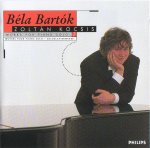Decca’s ongoing survey of Bartók’s solo piano works from Zoltán Kocsis now reaches Volume 7. Kocsis gives impressive, insightful performances, to which Bartók scholar László Somfai’s authoritative booklet notes add further distinction. The piano transcription of the Dance Suite (originally for orchestra) comes first. Kocsis delivers a thrilling account: he’s particularly good at making each multi-ethnic folk-inspired episode sound genuinely idiomatic, particularly where raw, primitive effects are employed, and he has the technique and stamina needed to traverse vast dynamic extremes, too. Kocsis also has an instinctive gift for timing and emphasis, something you’ll notice instantly in the Arabic dance setting (No. 4), and even more strongly in the indigenous Magyar sections, where the thrust and vibrancy of the playing is always underpinned by phenomenal technique and a spontaneous sense of theatre (stressed by delayed off-beat accents) that this music always needs.
György Sándor, a disciple of Bartók who gave the 1945 New York premiere and recorded the suite for CBS (Sony), gives a performance that rivals Kocsis in its power and primitivism, but he takes fewer chances and never lives as dangerously. With Kocsis, it’s a roller-coaster ride! The finale brings playing that’s often uncomfortably close to the edge, but the effect is so gripping that his account soon becomes addictive. Others, like György Sebok (Erato), take fewer liberties with rhythm and dynamics, but its usually a mistake to try to make this music sound any less ruthless or acerbic than Bartók intended. There’s far less to choose between Sándor and Kocsis, except in the concluding section where Kocsis goes wild.
Bartók’s Rhapsody Op. 1 is heard in both the original 1904 version and the shorter 1908 revision, and it’s useful to be able to compare the two editions on the same disc. Kocsis gives a barnstorming account of this astonishing piece of Bartók juvenilia but leaves you in no doubt that the first version is the best. The only minor caveat might be that Kocsis doesn’t always fully explore the mysterious side of Bartók’s music. I’m thinking especially of passages based on the slow, deliberate “Verbunkos” (recruiting) dance patterns so beloved in Liszt’s slow-fast rhapsody formula. Kocsis doesn’t always create the spine-chilling intensity and atmosphere that these slower sections should afford, but since Sándor’s version is presently unavailable this is more than satisfactory, and the short pieces that complete this issue are also very well done. [8/25/2001]
































